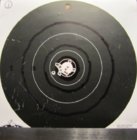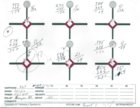Ned Ludd
Silver $$ Contributor
BB - In response to your initial question, the idea of an Optimal Charge Weight (OCW) test is to find two (or more) successive charge weight increments where the center-points of the groups maintain the same point of impact (POI) on the target. In other words, you're looking for a charge weight "window" over which the barrel harmonics are such that the POI remains relatively constant as charge weight/velocity change. You might call it the "sweet spot" where altering charge weight and velocity have minimal effect on where the bullet hits the target. So one important criteria for selecting a charge weight is that the POIs of the two to three successive groups' [center-points] aren't moving around on the target. IF you see a target with two successive groups that look right, the OCW will likely lie about halfway in between the two. If there are three groups in a row where the center-points maintain constant POI, the OCW will likely be closest to the middle charge weight of the three.
During the initial charge weight optimization stage of an OCW test, group size/shape has less to do with the selection process than POI. The reason for this is that you will tune in the group size/shape in the next step with seating depth. Nonetheless, you can certainly use group size/shape in addition to POI as a secondary indicator. For example, both your groups at 24.8 are stacked vertically, and the groups at 25.0 are stacked horizontally. Both are hitting the target in very close to the same POI, suggesting a potential charge weight window with the middle at 24.9. A reasonable hypothesis is that a charge weight halfway between them might stack the bullets into a single hole, in addition to maintaining the same POI on the target (i.e. with little vertical or horizontal stringing). That is certainly a testable hypothesis.
Once you have selected a charge weight for further testing, move on to seating depth testing in order to fine tune the groups. I typically start testing from ~.003" off the lands to around .027" or .030" off the lands initially, in .003" increments. I have yet to find a .224" bullet that wouldn't tune in somewhere within that region. Nonetheless, if you don't find a seating depth you like within that range, you could always go back and seat them into the lands, or farther off the lands.
I took the liberty of making a few estimates and running your load parameters through the reloading program, QuickLoad. I had to guess at the barrel length (I used 24"), the COAL you used (I used 2.260 COAL), and the case volume (I used 30.0 gr). Below are the QL outputs. Based on barrel time, the 24.4 gr load may be an in-between node, as it seems to give relatively good precision and uniform group shape, but is perhaps not as tight as you'd really like it to be. The 24.9 gr load falls spot on the barrel time predicted for OBT Node 4, a node I have had very good results with in the .223 Rem using heavy bullets. QL predicted your MAX pressure load to be 26.1 gr for the .223 Rem cartridge (right at 55,000 psi predicted pressure). You could certainly go a bit higher than that if you wanted to, but I can tell you from past experience that brass life will almost certainly be poor if you do, so why risk it? Moreover, it is questionable based on the fill ratio whether you can even get much more than 26.1 gr to fit in the case, and you won't be able to hit the next faster OBT Node even if you can.
Regardless, the key takeaways from the QL data are that 24.9 gr, and possibly 24.4 gr are worth further testing, i.e. tuning with seating depth. I will re-iterate that there are many caveats to using QuickLoad, such as the "guesstimates" I had to make regarding barrel length, case volume, etc. As such, it has its limitations. Nonetheless, I have found that once QL has been "calibrated" for a given rifle setup (i.e. the burn rate (Ba) in the program for a specific powder has been adjusted so that both predicted and measured velocity match exactly), the outputs are quite good. Keep going, you're making some good progress! I think you're being overly optimistic with regard to shooting 700 yd with a relatively light, flat-base 0.224" bullet, but you can figure out what your setup is capable of in terms of longer range once you get a solid load tuned for it. You need a tuned load to do that, so you're doing the right things up front.


During the initial charge weight optimization stage of an OCW test, group size/shape has less to do with the selection process than POI. The reason for this is that you will tune in the group size/shape in the next step with seating depth. Nonetheless, you can certainly use group size/shape in addition to POI as a secondary indicator. For example, both your groups at 24.8 are stacked vertically, and the groups at 25.0 are stacked horizontally. Both are hitting the target in very close to the same POI, suggesting a potential charge weight window with the middle at 24.9. A reasonable hypothesis is that a charge weight halfway between them might stack the bullets into a single hole, in addition to maintaining the same POI on the target (i.e. with little vertical or horizontal stringing). That is certainly a testable hypothesis.
Once you have selected a charge weight for further testing, move on to seating depth testing in order to fine tune the groups. I typically start testing from ~.003" off the lands to around .027" or .030" off the lands initially, in .003" increments. I have yet to find a .224" bullet that wouldn't tune in somewhere within that region. Nonetheless, if you don't find a seating depth you like within that range, you could always go back and seat them into the lands, or farther off the lands.
I took the liberty of making a few estimates and running your load parameters through the reloading program, QuickLoad. I had to guess at the barrel length (I used 24"), the COAL you used (I used 2.260 COAL), and the case volume (I used 30.0 gr). Below are the QL outputs. Based on barrel time, the 24.4 gr load may be an in-between node, as it seems to give relatively good precision and uniform group shape, but is perhaps not as tight as you'd really like it to be. The 24.9 gr load falls spot on the barrel time predicted for OBT Node 4, a node I have had very good results with in the .223 Rem using heavy bullets. QL predicted your MAX pressure load to be 26.1 gr for the .223 Rem cartridge (right at 55,000 psi predicted pressure). You could certainly go a bit higher than that if you wanted to, but I can tell you from past experience that brass life will almost certainly be poor if you do, so why risk it? Moreover, it is questionable based on the fill ratio whether you can even get much more than 26.1 gr to fit in the case, and you won't be able to hit the next faster OBT Node even if you can.
Regardless, the key takeaways from the QL data are that 24.9 gr, and possibly 24.4 gr are worth further testing, i.e. tuning with seating depth. I will re-iterate that there are many caveats to using QuickLoad, such as the "guesstimates" I had to make regarding barrel length, case volume, etc. As such, it has its limitations. Nonetheless, I have found that once QL has been "calibrated" for a given rifle setup (i.e. the burn rate (Ba) in the program for a specific powder has been adjusted so that both predicted and measured velocity match exactly), the outputs are quite good. Keep going, you're making some good progress! I think you're being overly optimistic with regard to shooting 700 yd with a relatively light, flat-base 0.224" bullet, but you can figure out what your setup is capable of in terms of longer range once you get a solid load tuned for it. You need a tuned load to do that, so you're doing the right things up front.


Last edited:













